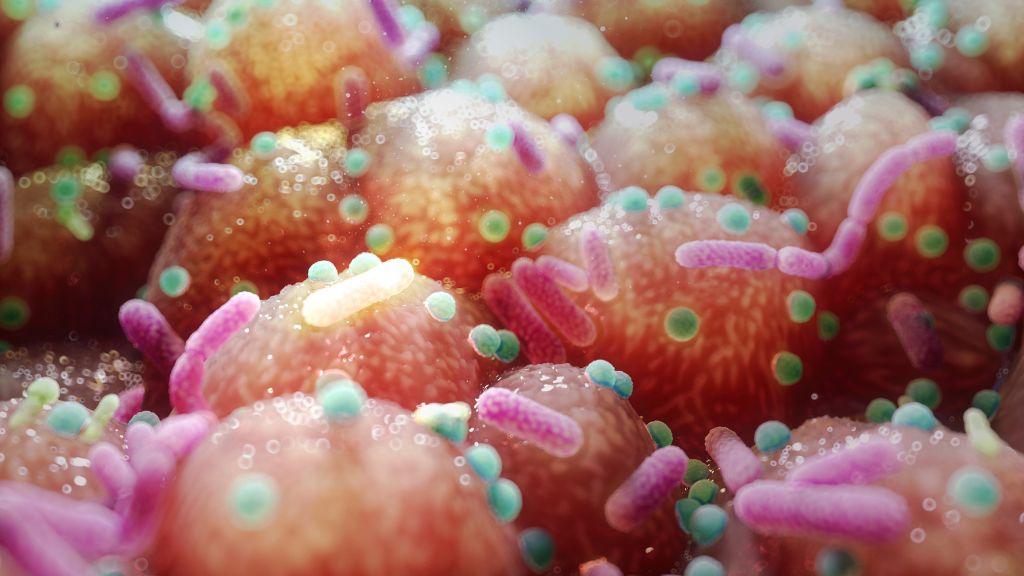High-sugar diet disrupts the gut microbiome, leading to obesity (in mice)
Sugar drives the overgrowth of specific bacteria.

Sugar may disrupt the community of bacteria living in the gut, thereby depleting crucial immune cells and causing obesity down the line, a new mouse study suggests.
So far, the results have been shown only in mice. But if follow-up studies show similar trends in humans, that could eventually lead to treatments for metabolic disease and obesity, said senior author Ivaylo Ivanov, an associate professor of microbiology and immunology at Columbia University Vagelos College of Physicians and Surgeons.
In the recent study, published online Aug. 29 in the journal Cell, scientists found that feeding mice a high-sugar diet containing sucrose and maltodextrin caused specific bacteria, called segmented filamentous bacteria (SFB), in the mice's intestines to die due to an overgrowth of different gut bugs. The sudden loss of SFB triggered a chain reaction in the mouse gut that ultimately changed how the animals absorbed dietary fat.
This, in turn, caused the mice to become obese and develop features of "metabolic syndrome," a cluster of conditions — such as high blood pressure, high blood sugar and insulin resistance — that collectively raise the risk of heart disease, stroke and type 2 diabetes.
Related: Gut bacteria may 'talk' to the brain, mouse study suggests
The results suggest that SFB somehow protect against metabolic syndrome and excess weight gain, but how do the gut bugs do it? It turns out that SFB "talk" to the immune system, encouraging the production of a specific type of immune cell called Th17. These immune cells release proteins that affect the lining of the intestine, preventing excess fat from being absorbed through the tissue and into the bloodstream.
Broadly, SFB can be found in many animals — including rodents, fish and birds — but they haven't been found in humans, Ivanov noted. However, humans do carry a different set of gut bacteria that can induce Th17 cells just like SFB do, and early research hints that these bacteria may be similarly depleted by high-sugar diets, he said. In other words, although humans may not carry SFB, sugar may still exert similar effects on the mouse and human gut microbiomes and immune systems.
Sign up for the Live Science daily newsletter now
Get the world’s most fascinating discoveries delivered straight to your inbox.
"Really what's providing the effect is the T cells — so the bacteria are inducing the T cells, and T cells are providing the effect," Ivanov told Live Science. "We hypothesize that, in humans, inducing these T cells will also be beneficial."
In their recent mouse study, the researchers placed mice on a high-sugar, high-fat diet for a month to see how their gut bugs might change. They found that the diet spurred the growth of a bacterium called Faecalibaculum rodentium, which essentially crowded out the SFB growing in the mouse gut, depleting its numbers. As the mice steadily lost SFB, their overall number of Th17 cells also fell, and they gained weight and developed insulin resistance and glucose intolerance — all signs of metabolic syndrome.
These effects weren't observed in mice that were fed a low-sugar, low-fat diet, or in mice fed a sugar-free, high-fat diet, but mice fed a high-sugar, low-fat diet also swiftly lost their SFB. This suggests that it was specifically the sugar that was driving the harmful loss of the bacteria and the Th17 cells.
Basically, the Th17 cells provided an "armor" that protected the mice from developing metabolic disease, and sugar indirectly destroyed that armor by messing with the microbiome, Ivanov explained.
In a different experiment, the team eliminated SFB from a group of mice and then fed them a sugar-free, high-fat diet. They found that these mice also gained weight and developed metabolic disease, despite not having eaten sugar. So what gives? In essence, without the right gut bugs, the mice didn't make enough Th17 cells and they thus lacked that aforementioned armor. The team found that they could provide that armor in two ways: by feeding the mice a probiotic imbued with SFB or by directly injecting Th17 cells into their bodies.
This suggests that, if a mouse's gut has already been depleted of SFB, cutting down on sugar won't help the rodent avoid metabolic disease. If this finding carries over to humans, that suggests that consuming less sugar wouldn't necessarily be helpful if one's gut microbiome is already disrupted. Therefore, an additional intervention might be needed to restore the gut bugs or Th17 cells of those people, Ivanov said.
Again, more research is needed to know if similar forces are at work in the human gut. Ivanov and his team are also trying to understand how gut bacteria help Th17 cells grow in the mouse gut and whether that mechanism also applies in humans.
"Even after 10 years of studying this, we don't understand completely this process, this mechanism, how exactly the bacteria is inducing these T cells," Ivanov said. "We know a lot, but still there are a lot of questions."
Originally published on Live Science.

Nicoletta Lanese is the health channel editor at Live Science and was previously a news editor and staff writer at the site. She holds a graduate certificate in science communication from UC Santa Cruz and degrees in neuroscience and dance from the University of Florida. Her work has appeared in The Scientist, Science News, the Mercury News, Mongabay and Stanford Medicine Magazine, among other outlets. Based in NYC, she also remains heavily involved in dance and performs in local choreographers' work.









